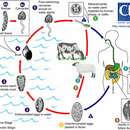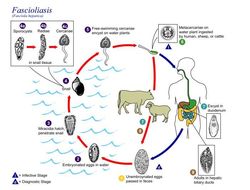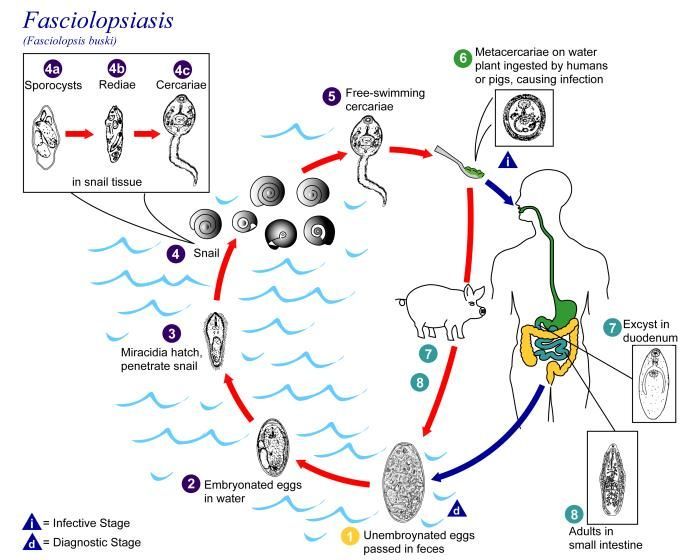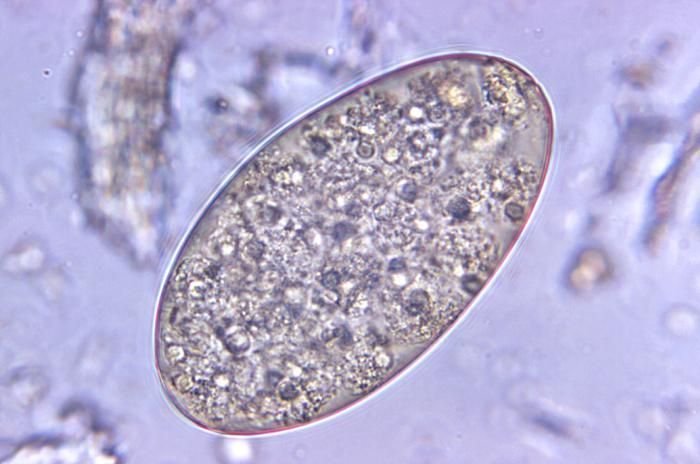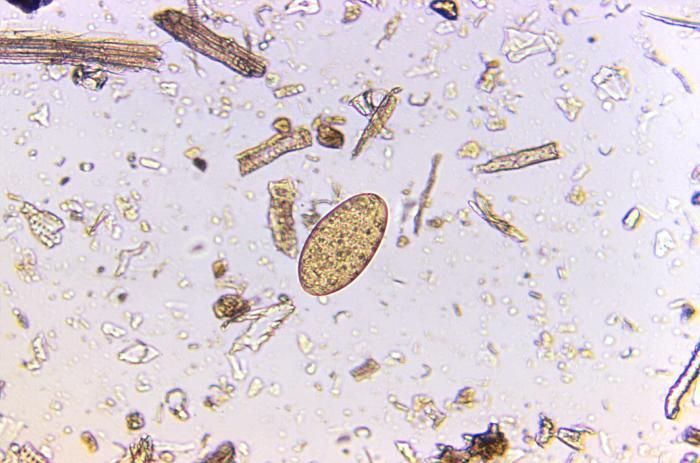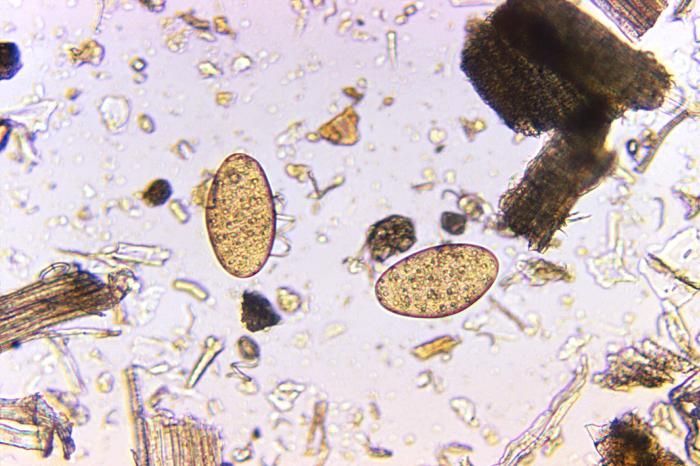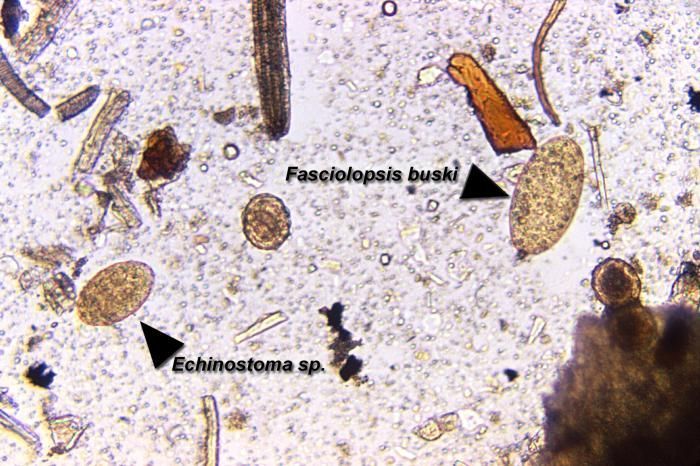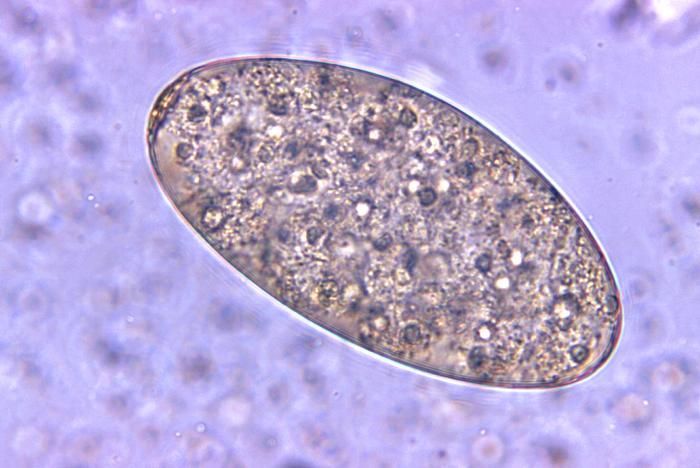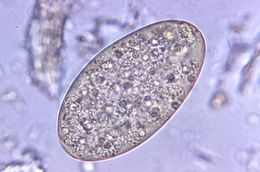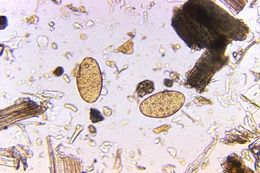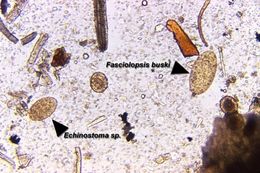-
This is an illustration of the life cycle of Fasciolopsis buski, the causal agent of Fasciolopsiasis.Created: 2002
-
Magnified 500X, this photomicrograph revealed the presence of a Fasciolopsis buski trematode egg that was found in an unstained formalin-preserved stool sample. F. buski are the largest intestinal flukes found parasitizing human beings. These flukes inhabit Asia and the Indian subcontinent, especially in areas where humans raise pigs, and consume freshwater plants.Clinical Features:Most infections are light and asymptomatic. In heavier infections, symptoms include diarrhea, abdominal pain, fever, ascites, anasarca and intestinal obstruction.Laboratory Diagnosis:Microscopic identification of eggs, or more rarely of the adult flukes, in the stool or vomitus is the basis of specific diagnosis. The eggs are indistinguishable from those of Fasciola hepatica.Created: 1973
-
Magnified 125X, this photomicrograph revealed the presence of a Fasciolopsis buski trematode egg that was found in an unstained formalin-preserved stool sample. F. buski are the largest intestinal flukes found parasitizing human beings. These flukes inhabit Asia and the Indian subcontinent, especially in areas where humans raise pigs, and consume freshwater plants.Clinical Features:Most infections are light and asymptomatic. In heavier infections, symptoms include diarrhea, abdominal pain, fever, ascites, anasarca and intestinal obstruction.Laboratory Diagnosis:Microscopic identification of eggs, or more rarely of the adult flukes, in the stool or vomitus is the basis of specific diagnosis. The eggs are indistinguishable from those of Fasciola hepatica.Created: 1973
-
Magnified 125X, this photomicrograph revealed the presence of two Fasciolopsis buski trematode eggs that were found in an unstained formalin-preserved stool sample. F. buski are the largest intestinal flukes found parasitizing human beings. These flukes inhabit Asia and the Indian subcontinent, especially in areas where humans raise pigs, and consume freshwater plants.Clinical Features:Most infections are light and asymptomatic. In heavier infections, symptoms include diarrhea, abdominal pain, fever, ascites, anasarca and intestinal obstruction.Laboratory Diagnosis:Microscopic identification of eggs, or more rarely of the adult flukes, in the stool or vomitus is the basis of specific diagnosis. The eggs are indistinguishable from those of Fasciola hepatica.Created: 1973
-
Magnified 125X, this photomicrograph revealed the presence of two trematode eggs, a Fasciolopsis buski egg on the right, and an Echinostoma sp. egg seen of the left, which were found in an unstained formalin-preserved stool sample. Note how much larger the F. buski is compared to that of the Echinostoma sp. egg. F. buski trematodes are the largest intestinal flukes found parasitizing human beings. These flukes inhabit Asia and the Indian subcontinent, especially in areas where humans raise pigs, and consume freshwater plants.Created: 1973
-
Magnified 125X, at its center, this photomicrograph revealed the presence of a Fasciolopsis buski trematode egg found in an unstained formalin-preserved stool sample. F. buski are the largest intestinal flukes found parasitizing human beings. These flukes inhabit Asia and the Indian subcontinent, especially in areas where humans raise pigs, and consume freshwater plants.Created: 1972
-
Magnified 500X, this photomicrograph revealed the presence of a Fasciolopsis buski trematode egg found in an unstained formalin-preserved stool sample. F. buski are the largest intestinal flukes found parasitizing human beings. These flukes inhabit Asia and the Indian subcontinent, especially in areas where humans raise pigs, and consume freshwater plants.Created: 1973
-
This is an illustration of the life cycle of the causal agents of Fascioliasis.Created: 2002

